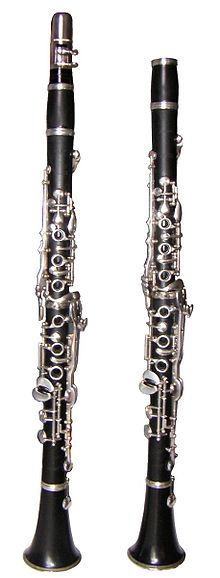- Öhler system
-
The Oehler system is a system for clarinet keys developed by Oskar Oehler. Based on the Müller system clarinet, the system adds tone holes to correct intonation and acoustic deficiencies, notably of the forked notes (B♭ and F). The system has more keys than the Boehm system, up to 27 in the Voll-Oehler system (full Oehler system). It also has a narrower bore and a longer, narrower mouthpiece leading to a slightly different sound. It is used mostly in Germany and Austria. Major developments include the patent C♯, low E-F correction, fork-F/B♭ correction and fork B♭ correction. Fingering charts can be found for example in this reference[1].
Oehler system clarinet makers
Oskar Oehler had three students: F. Arthur Uebel, Ludwig Warschewski and K.F. Todt. Uebel[2] and Todt are legendary clarinet makers in Germany, while Warschewski moved to Stockholm and became the solo clarinetist of Stockholm Philharmonic. Warschewski bought semi-finished Uebel clarinets and worked on the bore and mechanics. His clarinets are used by famous clarinetists like Dieter Klöcker. Uebel clarinets were used by Karl Leister when he first joined the Berlin Philharmonic; later he changed to Wurlitzer. Wurlitzer clarinets[3] made before the 1970s sounded very much like the Uebel clarinets while the bigger bore gave them better intonation. After the 1970s, Wurlitzer made some modifications to their design. Wurlitzer clarinets are now used in the great majority of German orchestras. They are very expensive, but some Wurlitzer apprentices are producing similar clarinets for less.
References
- ^ http://www.wfg.woodwind.org/clarinet/ clarinet fingering charts for different clarinet types
- ^ http://uebel-klarinetten.de F. Arthur Uebel clarinets (in German)
- ^ http://www.wurlitzerklarinetten.de Wurlitzer clarinets
Clarinet Clarinet family Systems of Fingering Clarinetists Heinrich Baermann · Acker Bilk · Walter Boeykens · Jack Brymer · James Campbell · Eddie Daniels · Buddy DeFranco · Eric Dolphy · Stanley Drucker · Pete Fountain · Martin Fröst · Benny Goodman · Woody Herman · Thea King · Henry Lazarus · Karl Leister · Sabine Meyer · Pee Wee Russell · Artie Shaw · David Shifrin · Anton Stadler · Milenko Stefanović · Richard StoltzmanClarinet makers Category:Clarinet makers · Category:Clarinet manufacturing companies · List of clarinet makers · Amati-Denak · E. K. Blessing · Buffet Crampon · Johann Christoph Denner · Benedikt Eppelsheim · Stephen Fox · Heinrich Grenser · Howarth of London · Jupiter Band Instruments · Leblanc · Iwan Müller · Adolphe Sax · Selmer · Yamaha CorporationOther Category:Clarinets · Category:Compositions for clarinet · Clarinet choir · Clarinet concerto · Clarinet sonata · Clarinet-violin-piano trio
This article relating to woodwind instruments is a stub. You can help Wikipedia by expanding it.

